Searching for Winter’s Gifts in Baxter State Park
Writer and outdoor guide Jenny O’Connell brings friends on a snowy expedition to find peace in Maine’s wilderness.
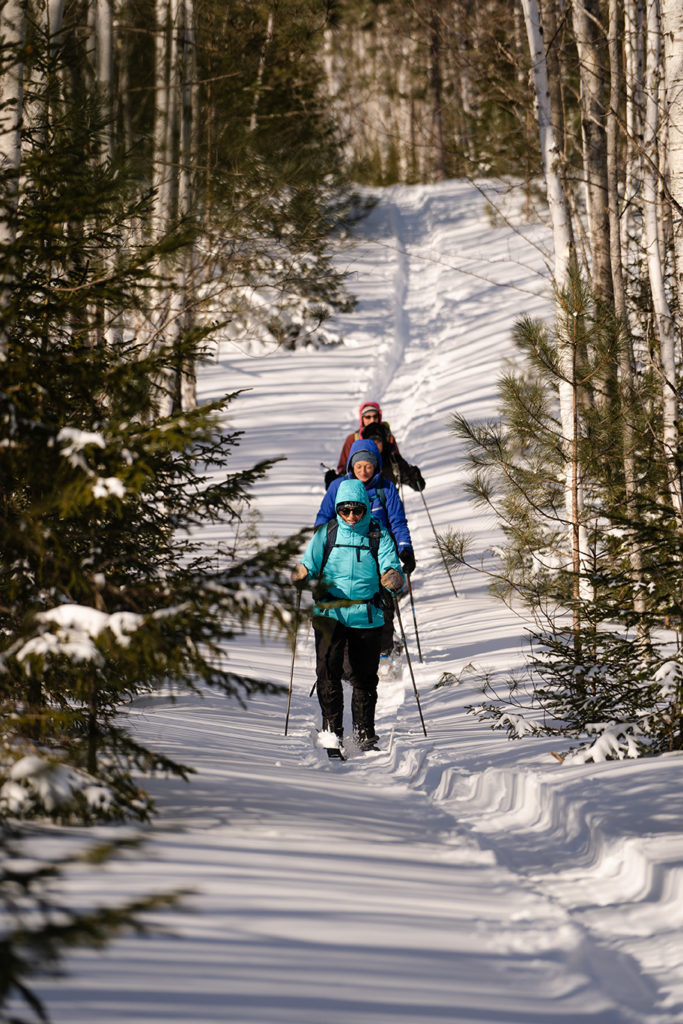
Searching for Winter’s Gifts
in Baxter State Park
Writer and outdoor guide Jenny O’Connell brings friends
on a snowy expedition to find peace in Maine’s wilderness.
by Jenny O’Connell
Photography by Andy Gagne
Issue: January // February 2023
When I mention that I’m about to put on a pair of snowshoes and walk out into the winter for three days, people like to dwell on the danger. It’s true that there are plenty of ways a body can freeze, or suffer harm in the cold. Anyone who’s been in Maine in February knows the precise way the wet Northeast chill cuts through your bones, or how icicles form in your nostrils in the early morning. But what nobody talks about is the peace.
For Mark Lessard, who grew up hunting along the Golden Road with his brother, peace is coming home to a place he used to know. “I’ve forgotten the way it feels to be out here,” he says, though there’s an extra spark in his eyes today, and I can tell he’s starting to remember. For my sister Caitlin, peace comes with a suspension of routine. “The things I’m thinking about on this trip are not the things I think about in the day-to-day,” she says. And she’s right: out in the winter woods, a simplification happens. Instead of, How do I fill my time? the question becomes, How do I care for myself? The answer is kindling a fire, donning a layer, chipping a water hole in the ice, warming boot liners.


For me, it’s the walking that does it. I’ve spent three days packing and planning, second-guessing and packing again, shopping for food, running my hands over the hatchet, the shovel, the first-aid kit, the stove. Everything we need to not die is strapped to our sleds. Once the trailhead is out of sight the hum of snowmobiles along the Golden Road fades, with it goes my unanswered emails, cell phone service, and all the effort it took to get here. The six of us fall quiet. There’s only the rhythmic crunch of snowshoes, the clicking of poles. My breath, a cloud in the icy air. I’m arriving.
We slide through slender birch forests, past lichen-crusted boulders capped with ice. Here, a moose has rubbed his antlers against the bark. There, a crunched spruce branch kicks up citrus on the breeze. Temperature is a familiar struggle: I’m too cold, and then I’m too hot. Cold, hot. I sweat through my shirt, but as soon as I stop to take off a layer, my sweat freezes, and I’m cold again. The snow on the trees brings the sound in close. The world is white, green, gray. It’s the slick red bark of a sapling, the sloping blue-purple ridge of Katahdin.
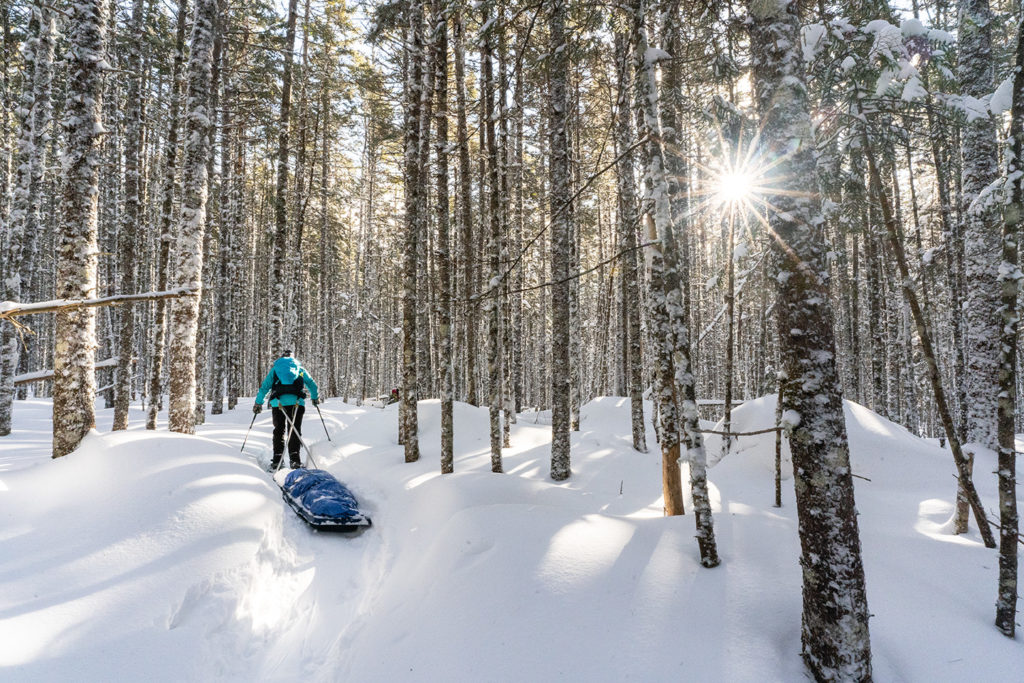
The land we’re traveling on is the unceded, ancestral territory of the Wabanaki people, the first stewards of the area (who, it feels important to note, have been omitted from the Baxter State Park website). The famed 5,269-foot mountain is sacred to the Penobscot tribe, who named it “Katahdin,” which we translate “Greatest Mountain.” Though every year roughly half of the park’s 60,000 visitors attempt to reach the summit, which marks the northern terminus of the Appalachian Trail, there are over 40 other peaks and ridges and 215 miles of trails in the park, which were patchworked together through a number of land purchases made by former governor Percival Baxter and donated to the State of Maine in 1931 under the condition that it be kept “forever wild.”
Up until 12,000 years ago, this whole area was buried under a glacier. As the Laurentide ice sheet melted, a boreal forest of spruce and fir grew in its place. A warming climate over the next 8,000 years allowed for the Acadian forest of birch, maple, white pine, hemlock, and balsam that we see today. Back in the present, the sun is dropping behind the mountains, tinting the snow orange. We step carefully across a frozen stream. The trail pitches and rolls gently through the spruces on its way to Kidney Pond, and for one glorious moment I am exactly the right temperature.
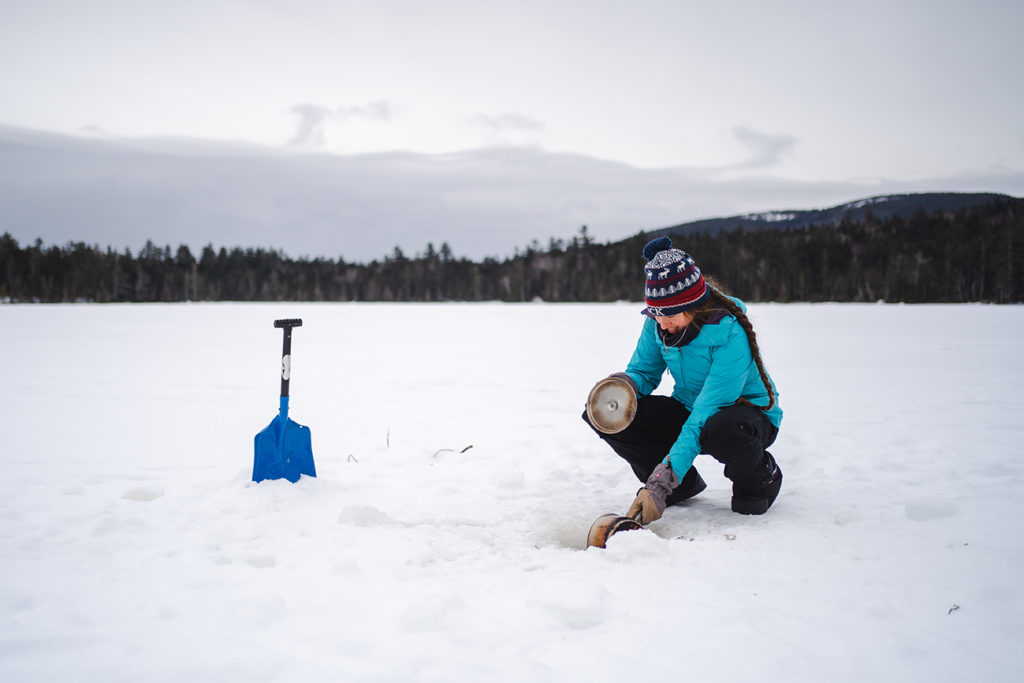
We are walking straight toward a snowstorm, and we know it. The meteorologists have been talking about it for days. This is causing a little bit of anxiety in our group, but snow doesn’t bother me. I learned how to live outside in the winter in 2014 when my outdoor mentor, Evan Perkins from Vermont’s Northeast Kingdom, asked me to guide a ten-day winter backpacking course with him in the sub-zero Adirondacks. Learning by doing—or throwing myself out of the nest and finding my wings on the way down—has always been my trademark style, but on that trip, I knew there would be less margin for error than usual. My parents, sick with worry, slept worse in their cozy home in the city than I did in the pit we dug out of snow and strung a tarp over each night. Those ten days in the frozen wilderness, the temperature often hovered around minus 14 degrees. But I learned much more than survival from Evan; I learned how to thrive, which really just meant paying attention and taking slow, careful time to attend to the little things. If I tucked my extra clothes and a Nalgene full of hot water down into my sleeping bag at night, I would sleep warm. If I kept my lighter in an inside pocket, it would never freeze. If my socks or gloves got wet, I could hike with them against my stomach to dry them out. I stashed granola bars in my pockets and ate them when I was cold or tired. I learned how to read the weather with my body—when my lips felt dry, or when short gusts of wind blew through, it meant a front was rolling in. Evan taught me how to identify trees without their leaves, and how to use the knowledge of which ones grow near water to help with navigation. I did not freeze. I did not die. I learned how to love the winter.
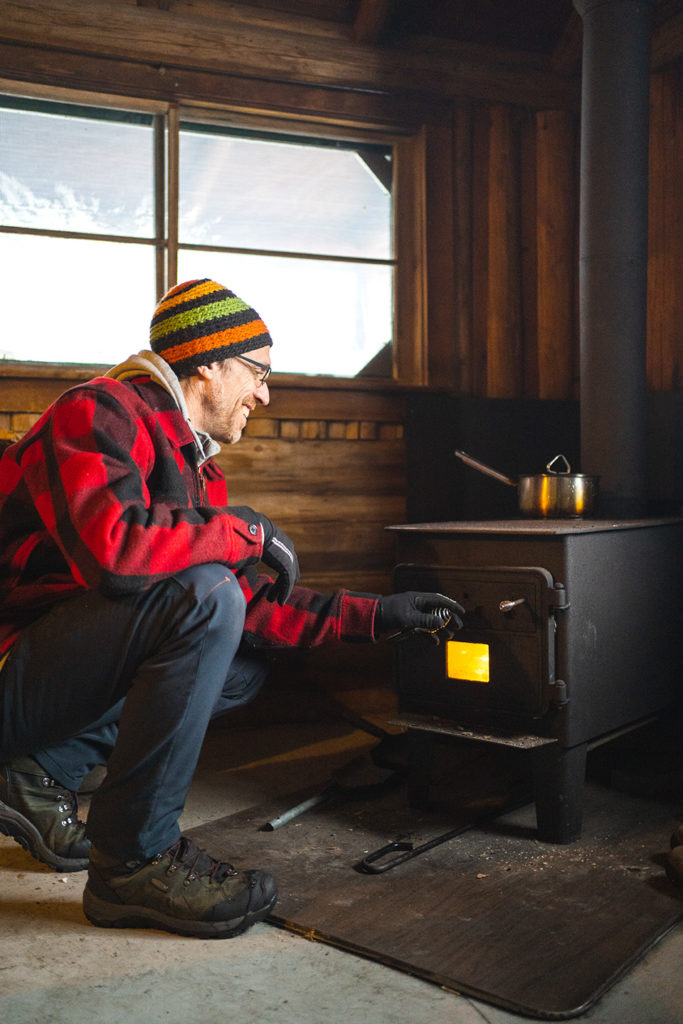

At Kidney Pond, the accommodations are a few notches up from Evan’s tarp in the snow. We’re staying in a rustic cabin lit by gas lamps and heated by a woodstove. Mark has made chicken tikka masala for dinner, and the sauce drips down our chins as we shovel steaming spoonfuls into our mouths, packing in extra calories in anticipation of a cold night. When we go outside to fetch water from the hole we’ve chipped in the pond, the sky has cleared and billions of stars settle over us like a curtain, glittering somehow brighter in the cold air.
After coffee the next morning, we take a Spikeball net out to the middle of the frozen pond and play, diving into the snow after a little yellow ball, until the sky fills with clouds and the storm rips in. It is, as promised, a big one: fat white snow flurries and howling wind. We strap on skis and snowshoes and walk out into the melee until the visibility drops and our cheeks are numb, then we turn and head for shelter. That night, we encounter the most unnerving task of the entire trip: finding the outhouse 40 yards away in the pitch-black during a blizzard. We have to get fully suited up just to pee. The snowdrifts are chest-high. Then we lie on our bunk beds with our eyes squeezed shut, pretending to sleep as cold, powdery snow drifts through the cracks in the log cabin and settles on our faces.


In the morning, the world looks brand-new, coated in two feet of fresh powder. We stoke the fire and make a plan. If the wind dies down, we’ll cut across the pond; if it doesn’t, we’ll stick to the trees and take the long way back to the car. It calms down just before we’re ready to leave. Sun sparkles on snow as we break trail across the frozen water.
Within every season there is an invitation. Summer in Maine is for action, for movement. It’s salty ocean air and warm lake swims, late-day picnics and a sun that doesn’t quit until nine. Fall is for transition, for soaking up the last of the light, for shedding what we no longer need. Spring stirs us, awakens us, promises us warmth again. And then there’s winter.
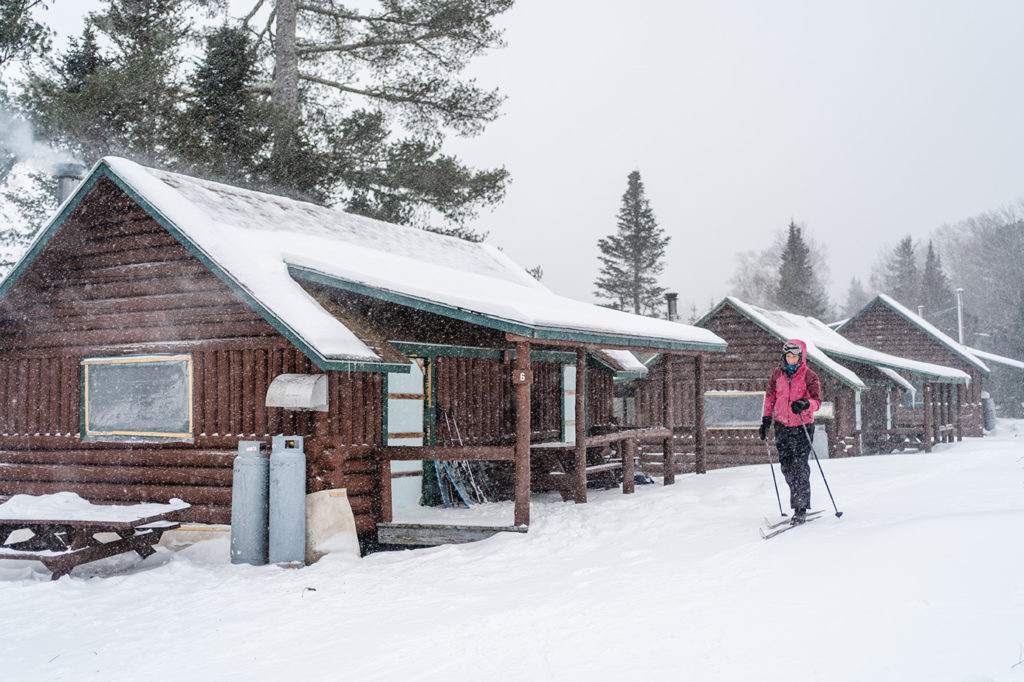

The wind has picked up again, but we’re across the pond, over the stream. As we reach our last mile, we pause at drama mapped out in the snow: a weasel trail abruptly interrupted by the imprint of owl wingtips. Our cheeks are flushed, and our eyes are bright. A small part of me is looking forward to a hot shower, but most of me wants to stay. I have spent plenty of cold, gray seasons just trying to muddle through, but somewhere along the way I have become a person who deeply, wildly loves the winter. Winter is an invitation to slow down, to sync up with the rhythms of quiet and dark, to go inward. I can cozy up with fellow travelers over a steaming bowl of dinner or walk out into a white, frozen landscape in search of new reserves of resilience. The challenge is always the same: to turn toward it. To open instead of close.
Read More:
- Branching Out

- 48 Hours in Cape Elizabeth, South Portland + Scarborough

- 4 Unique Winter Weekends

- Where to Cross-Country Ski This Winter

- Brunswick in 48 Hours


